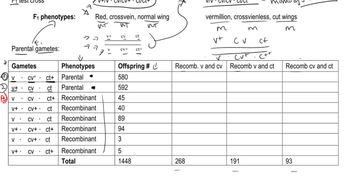Table of contents
- 1. Introduction to Genetics51m
- 2. Mendel's Laws of Inheritance3h 37m
- 3. Extensions to Mendelian Inheritance2h 41m
- 4. Genetic Mapping and Linkage2h 28m
- 5. Genetics of Bacteria and Viruses1h 21m
- 6. Chromosomal Variation1h 48m
- 7. DNA and Chromosome Structure56m
- 8. DNA Replication1h 10m
- 9. Mitosis and Meiosis1h 34m
- 10. Transcription1h 0m
- 11. Translation58m
- 12. Gene Regulation in Prokaryotes1h 19m
- 13. Gene Regulation in Eukaryotes44m
- 14. Genetic Control of Development44m
- 15. Genomes and Genomics1h 50m
- 16. Transposable Elements47m
- 17. Mutation, Repair, and Recombination1h 6m
- 18. Molecular Genetic Tools19m
- 19. Cancer Genetics29m
- 20. Quantitative Genetics1h 26m
- 21. Population Genetics50m
- 22. Evolutionary Genetics29m
2. Mendel's Laws of Inheritance
Sex-Linked Genes
Problem 24a
Textbook Question
In a species of fish, a black spot on the dorsal fin is observed in males and females. A fish breeder carries out a pair of reciprocal crosses and observes the following results.
Cross I Parents: black-spot male x nonspotted female
Progeny: 22 black-spot male
24 black-spot females
25 nonspotted males
21 nonspotted females
Cross II Parents: nonspotted male x black-spot female
Progeny: 45 black-spot males
53 nonspotted females
Identify which sex is heterogametic. Give genotypes for the parents in each cross, and explain the progeny proportions in each cross.
 Verified step by step guidance
Verified step by step guidance1
Identify the pattern of inheritance by analyzing the results of the reciprocal crosses. Note that the progeny ratios differ between the two crosses, suggesting a sex-linked trait.
Determine which sex is heterogametic. In many species, males are XY (heterogametic) and females are XX (homogametic), but in some species, like birds and some fish, females are ZW (heterogametic) and males are ZZ (homogametic).
Analyze Cross I: A black-spot male (assumed to be ZZ or XY) crossed with a nonspotted female (assumed to be ZW or XX) results in both black-spot and nonspotted progeny of both sexes. This suggests that the black spot trait is not sex-linked or is autosomal.
Analyze Cross II: A nonspotted male crossed with a black-spot female results in all black-spot males and all nonspotted females. This suggests that the black spot trait is linked to the sex chromosomes, with the black-spot allele being dominant and located on the Z or X chromosome.
Assign genotypes: In Cross I, the black-spot male could be Z^B Z^b or X^B Y, and the nonspotted female could be Z^b W or X^b X^b. In Cross II, the nonspotted male could be Z^b Z^b or X^b Y, and the black-spot female could be Z^B W or X^B X^b.
Recommended similar problem, with video answer:
 Verified Solution
Verified SolutionThis video solution was recommended by our tutors as helpful for the problem above
Video duration:
1mPlay a video:
Was this helpful?
Key Concepts
Here are the essential concepts you must grasp in order to answer the question correctly.
Sex Determination and Heterogamety
In many species, sex is determined by specific chromosomes, with males and females having different combinations. Heterogametic sex refers to the sex that has two different sex chromosomes (e.g., XY in many animals), while the homogametic sex has two of the same (e.g., XX). In this fish species, identifying which sex is heterogametic is crucial for understanding inheritance patterns and progeny outcomes.
Recommended video:
Guided course

Sex Determination
Genotype and Phenotype
Genotype refers to the genetic constitution of an organism, while phenotype is the observable physical or biochemical characteristics resulting from the genotype and environmental influences. In the context of the crosses, determining the genotypes of the parent fish (e.g., BB for black-spot and bb for nonspotted) helps explain the phenotypic ratios observed in the progeny.
Recommended video:
Guided course

Gamete Genotypes
Reciprocal Crosses
Reciprocal crosses involve switching the sexes of the parents in genetic experiments to determine the influence of sex on inheritance. By analyzing the results of both crosses in this fish study, one can assess whether the presence of the black spot is influenced by the sex of the parent, which aids in understanding the genetic basis of the trait.
Recommended video:
Guided course

Trihybrid Cross

 7:56m
7:56mWatch next
Master Sex-Linked Genes with a bite sized video explanation from Kylia Goodner
Start learningRelated Videos
Related Practice



